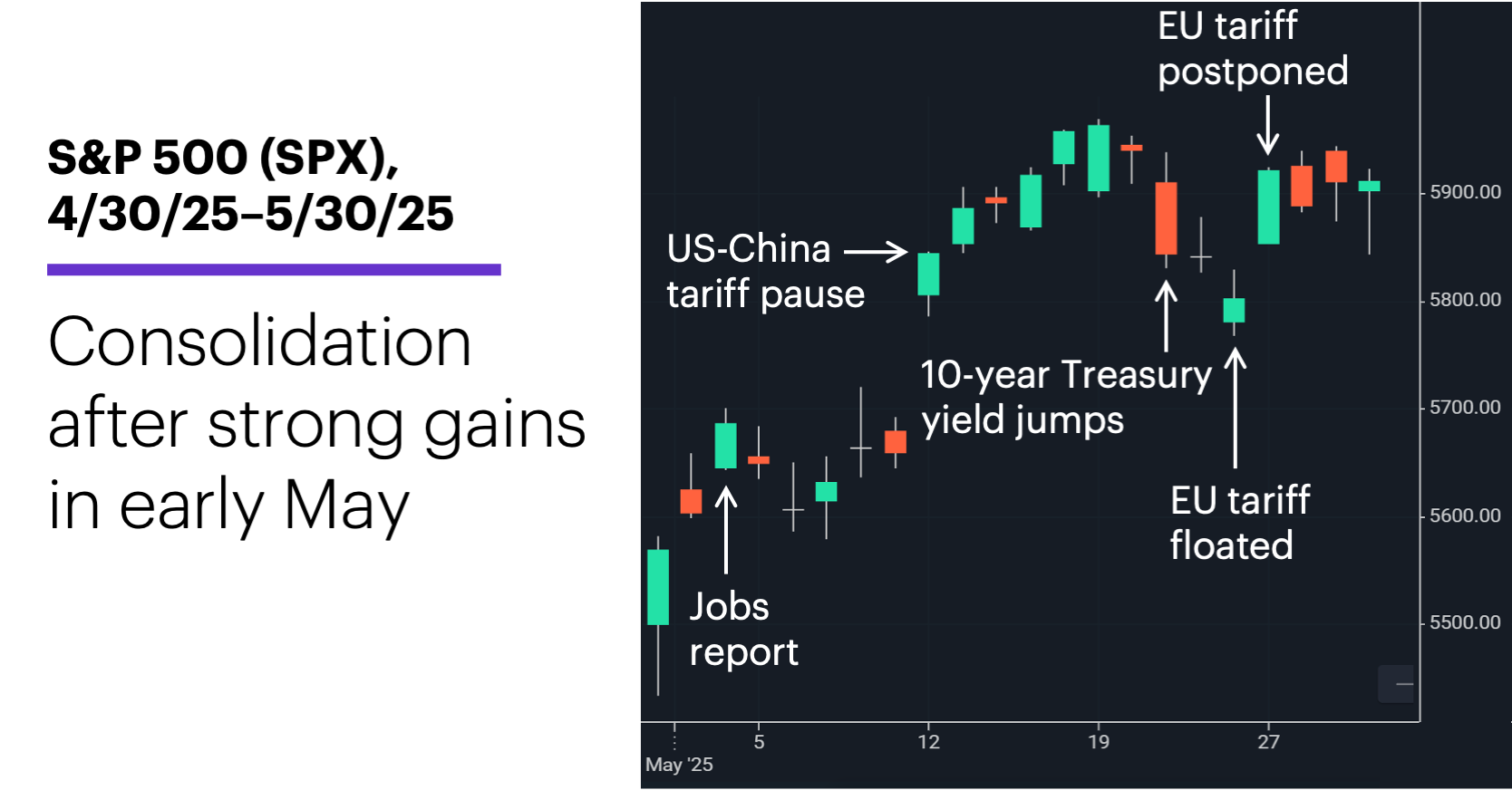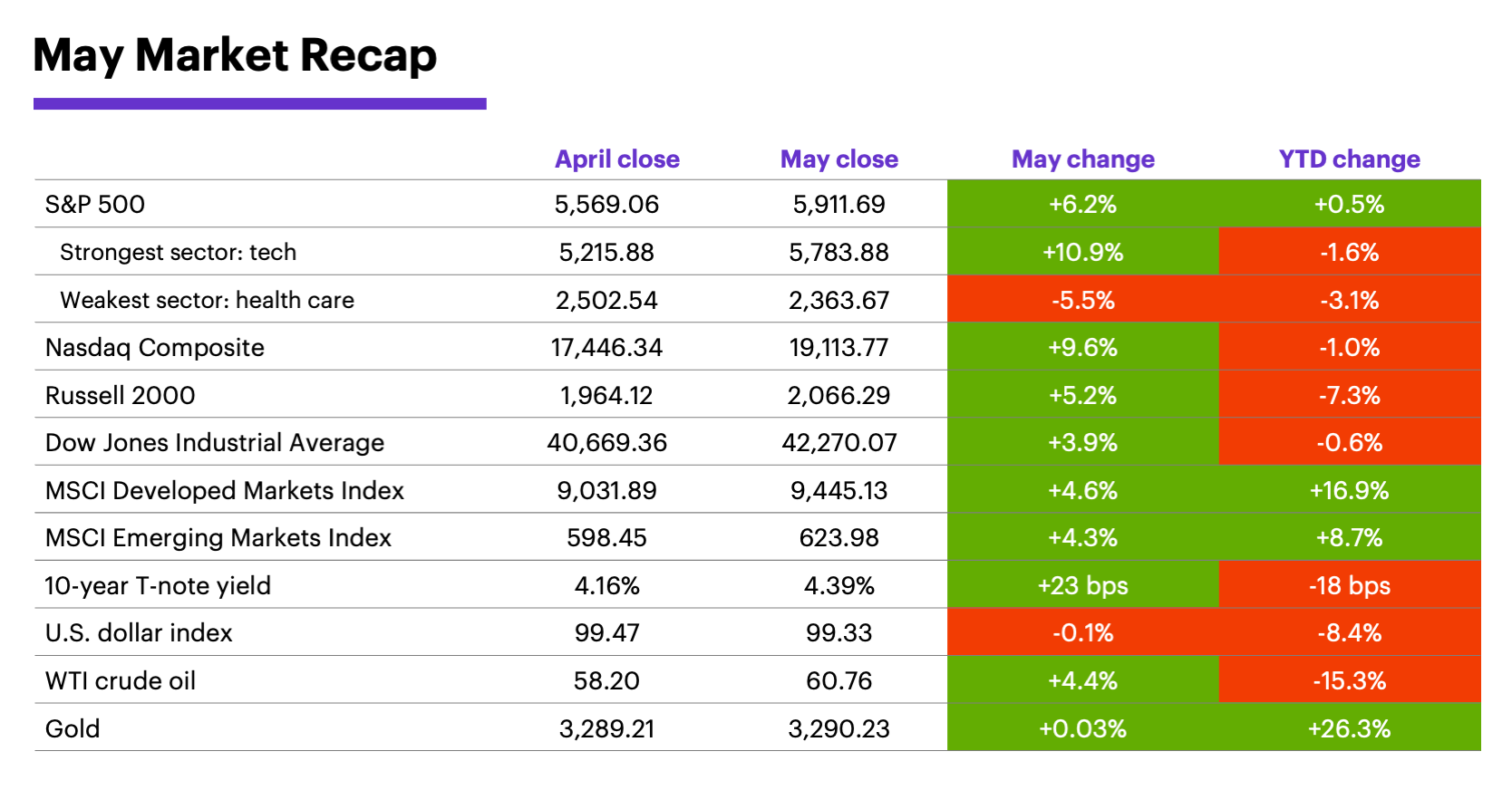Market extends range
E*TRADE from Morgan Stanley
Despite more twists and turns in the trade story and heightened concerns about debt and deficits, the S&P 500 wrapped up May where few people probably thought it would be a couple of months ago—less than 4% below its all-time high.
In fact, the S&P 500 followed its first three-month losing streak since 2023 with its best month since November 2023, and its strongest May since 1990. While tariffs remained the focal point for markets, a new theme emerged in the second half of the month—rising Treasury yields after the House of Representatives passed a spending package that some analysts estimate could add trillions of dollars to the US debt.

Source: Power E*TRADE. (For illustrative purposes. Not a recommendation. It is not possible to invest directly in an index.)
Trade concerns mostly eased last month, despite more on-again, off-again tariffs. The S&P 500’s two biggest up days last month occurred after US-China tariffs were paused on May 12, and following the quick postponement of EU tariffs on May 27. (Take away those two days, and the month’s return shrinks to 0.74%.) But a court battle over the constitutionality of the White House tariff campaign, President’s Trump’s claim that China had violated the terms of its trade agreement, and the doubling of tariffs on imported steel added a note of uncertainty to the final days of the month.
Inflation readings came in cool, and labor market data remained solid, but this month’s numbers could be the first to meaningfully reflect the impact of tariffs. That said, given a net de-escalation in trade tensions, Morgan Stanley & Co. economists still think the US economy can avoid recession, although high tariffs will likely “keep inflation firm, slow US GDP growth, and keep the Fed on hold into 2026.”1
“Risk-on” areas of the market were the biggest gainers. Tech and consumer discretionary stocks led the May rebound, while health care was the only S&P 500 sector to lose ground for the month.
US stocks outperformed international markets for the first time this year. The S&P 500 outgained both the MSCI Developed Markets Index and the MSCI Emerging Markets Index last month. Morgan Stanley & Co. favors US stocks over international markets for the remainder of the year, and expects the S&P 500 to reach 6,500 by the second quarter of 2026.2

Data source: Power E*TRADE and FactSet. (For illustrative purposes. Not a recommendation. It is not possible to invest directly in an index.) Note: crude oil, gold, and U.S. Dollar Index data reflect spot-market prices. BPS (basis point) = 0.01%. MSCI Index of Developed Markets and MSCI Emerging Markets Index represent “total-return” performance (index change including dividend reinvestment).
Treasury yields hit multi-month highs amid debt and deficit concerns. The benchmark 10-year Treasury yield ended May 23 basis points (0.23%) higher at 4.39%, but it hit 4.6% intraday on May 22 after the House passed the spending bill. Morgan Stanley & Co. strategists view higher long-term rates as the primary short-term risk to stocks, noting if yields remain elevated, they could “keep the S&P 500 in our first-half range of 5,500-6,100 before upward progress continues.”3
The House bill implies a greater near-term deficit but lower long-term deficit, according to Morgan Stanley & Co. policy strategists. But they also expect the final, Senate-approved version of the bill to potentially expand deficits more than the House bill.4
Although June has been a positive month for the US stock market in eight of the past 10 years, it has, on average, been one of the weaker months for the S&P 500 since 1957.
Insight of the month: Themes and variations. Morgan Stanley & Co. strategists recently identified six areas where the overlap of four key themes—rewiring commerce for a multipolar world, AI tech diffusion, the future of energy, and longevity—are creating new investment opportunities. They also provide a map of stocks tied to the four themes.5
June market patterns. While June was, on average, one of the weakest months of the year for the US stock market from 1957–1990, it has been moderately more bullish since. The S&P 500 had a positive return in 21 of the past 34 years, although its 0.16% median return was still the second-weakest of all months. The past decade has been something of a departure, with June positive eight times with a 1.2% median return.6
Key dates: Employment Report (6/6), CPI (6/11), PPI (6/12), retail sales (6/17), Fed interest rate decision (6/18), final Q1 GDP (6/26), PCE Price Index (6/27).
1 MorganStanley.com. Still Slow Growth, Firm Inflation. 5/20/25.
2 MorganStanley.com. All Eyes on US. 5/20/25.
3 MorganStanley.com. US Equities Mid-Year Outlook: Focus on Rate of Change. 5/21/25.
4 MorganStanley.com. FAQs: Tariff Man Meets Tax Man. 5/26/25.
5 MorganStanley.com. Thematic Investing: A Framework for Uncovering Alpha. 5/5/25.
6 Figures reflect S&P 500 (SPX) monthly closing prices, 1957–2024. Supporting document available upon request.
Because of their narrow focus, sector investments tend to be more volatile than investments that diversify across many sectors and companies. Technology stocks may be especially volatile. Risks applicable to companies in the energy and natural resources sectors include commodity pricing risk, supply and demand risk, depletion risk and exploration risk. Health care sector stocks are subject to government regulation, as well as government approval of products and services, which can significantly impact price and availability, and which can also be significantly affected by rapid obsolescence and patent expirations.
Yields are subject to change with economic conditions. Yield is only one factor that should be considered when making an investment decision.